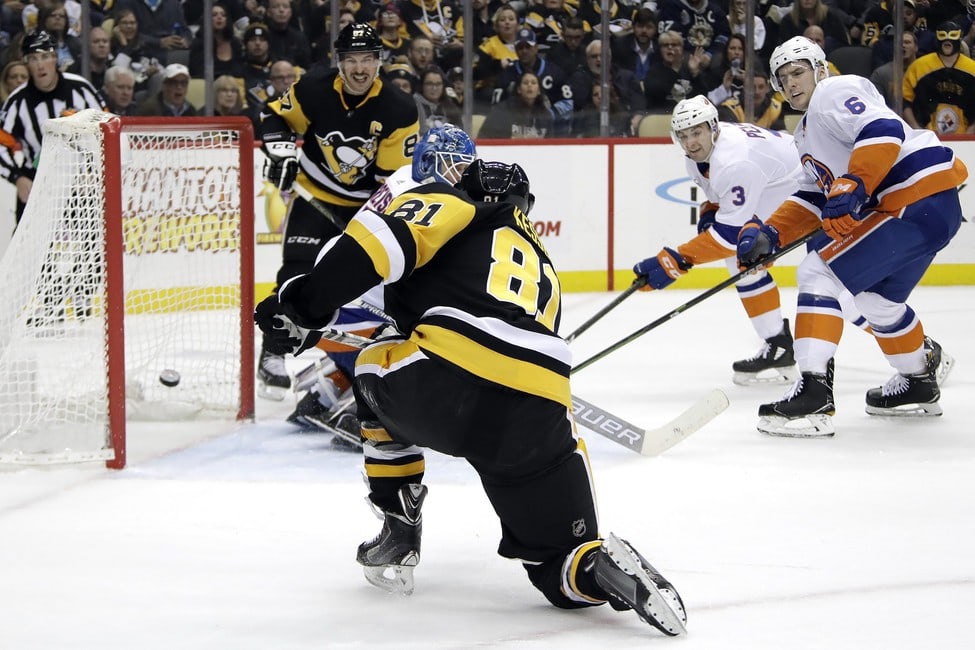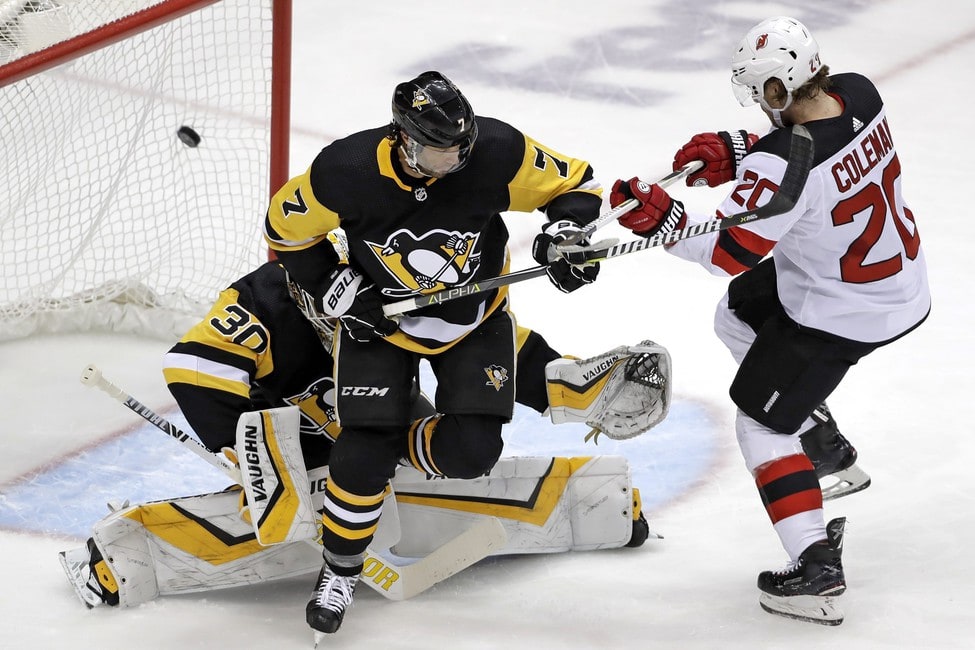![]()
The Pittsburgh Penguins have made a habit of coasting early then flipping the switch, but it’s now mid-February, and the switch still hasn’t been flipped. It has the team in danger of missing the playoffs for the first time since the 2005-06 season, the first of the Sidney Crosby era.
As of Feb. 18, the Penguins sit just one point up on a playoff spot with the red hot Carolina Hurricanes, who have a game in hand, right on their tail. However, they have nobody to blame but themselves for being in this position.
With one of the most talented rosters in the league you might be asking, how are the Penguins in this situation? It’s simple. They’ve been killed by inconsistent play in all areas of the game and inconsistent performances against teams they should be beating. It has the potential to sink them if they can’t figure it out, but could there be a sign of hope?
In this week’s Penguins Pulpit, we look at superstar Evgeni Malkin returning to form right when the Penguins need him to, their inconsistency against inferior teams and Patric Hornqvist’s sudden struggle to score.
2018-19 Record: 31-21-7, 69 points (4th in Metropolitan Division, 7th in Eastern Conference, 11th in League Standings)
Malkin Has Returned to Form
It’s been a long time coming, but the Malkin who takes over a game when he pleases looks to be back.
After starting the season with 19 points in 10 games in the first month of the season, Malkin looked locked in and poised to surpass the 100-point plateau for the first time since the 2011-12 season, but the 32-year-old fell into a deep slump over the next two-plus months. From Nov. 1, 2018, to Jan. 1, 2019, Malkin recorded 21 points in 29 games. For many players that production would be fine. For Malkin, it qualified as a serious slump.

While he remained a point-a-game player for the season, it was clear he wasn’t the Malkin everyone was accustomed to seeing. He looked slower, lost the puck a lot, had poor decision making and was a five-on-five ghost most nights. There were no concerns that he was declining, but it was clear something was up with him. He started to put points up more consistently toward the end of 2018 and into 2019, but there was still something missing.
Malkin showed some signs of life before missing five games with a neck issue following a hit from Dan Girardi during the Penguins’ matchup against the Tampa Bay Lightning on Jan. 30. Upon returning Monday night against the Philadelphia Flyers, he let everybody know his slump was over, and in a big way.
It started on a sour note after he received a one-game suspension for taking a swing at Michael Raffl’s head late in the third period of last Monday night’s game. Trying to take a man’s head off aside, Malkin looked a lot better than he had at any point during the previous two months.
His real return to form took place over the weekend in the Penguins’ matchups with the Calgary Flames and New York Rangers. Malkin recorded five points in the two games and capped it off with a goal of the year candidate in the third period of Sunday’s game when he took a pass from Zach Aston-Reese and fired a spin-o-rama backhand by the Rangers’ Alexandar Georgiev to put the Penguins up 6-3 at the time.
It wasn’t just Sunday’s goal that let everybody know Malkin’s back. It was his dominance every shift and every time he touched the puck. He had the kick in his step he’d been missing for the last three months. There was no taking the puck off of him no matter what the Flames and Rangers did. He looked like the Malkin that, once he comes around, he doesn’t leave for a long time.
His success this weekend brings hope to the team. Hope that he can have a similar performance down the line as he did last season when he put up 62 points in 42 games after Jan. 1, 2018. His post-Jan. 1, 2019 numbers? Six goals, 15 assists, and 21 points in 14 games. An almost identical per-game pace to the one he put up in the second half of last season. It puts him on-pace for 34 points over the Penguins’ final 23 games of the season, and it’d go a long way to helping the team secure a playoff berth.
The fact that anybody can notice a slump from a player who hasn’t dropped below a point-agame average all season is a testament to Malkin’s greatness and the expectations that surround him. Even when he wasn’t at his best, he still had a significant impact on the Penguins by merely being in the lineup and forcing teams to choose their matchups wisely.
A healthy, and dominant, Malkin is the best possible addition the Penguins can make to their lineup ahead of the Feb. 25 NHL Trade Deadline, and it looks like they’re getting just that.
Inconsistency May Cost the Penguins a Playoff Spot
While Malkin and a majority of the Penguins’ top players are firing on all cylinders, the team as a whole has been inconsistent at best.
Some nights they look like nobody can stop them, and other nights it seems like a team made up of 20 members of the crowd could run them out of the building. That’s a major problem. It doesn’t matter how much talent the Penguins possess, winning a Stanley Cup while being as inconsistent as they’ve been is out of the question.
The most confusing part of the Penguins’ poor performances is they almost exclusively occur against opponents who aren’t in a playoff spot, which fuels the narrative that they play down to inferior teams. On the flip side, the Penguins are seemingly on top of their game whenever a playoff team shows up on the schedule. So what are the facts?
Record vs. Non-Playoff Teams:
15-11-4; a 92-point pace
104 Goals For; 3.5 goals-per-game
100 Goals Against; 3.3 goals against per-game
Record vs. Playoff Teams:
16-10-3; a 99-point pace
99 Goals For; 3.4 goals-per-game
84 Goals Against; 2.9 goals against per-game

Seven points don’t seem like much, but the difference between 99 points and 92 points is the difference between making the playoffs for the 13th consecutive season and missing them altogether.
Since the wild card introduction before the 2013-14 season, the lowest point total for a qualifying team in the Eastern Conference was 93, recorded by the 2013-14 Columbus Blue Jackets and 2013-14 and 2015-16 Detroit Red Wings. The average point total by the lowest seed over those five seasons has been 95 points. So 99 points would give them a good chance, while 92 would likely leave them on the outside looking in. As it stands right now, the Penguins are on-pace for 96 points, so it’s going to come down to the wire if they’re unable to string a decent streak together.
What could end up costing the Penguins a playoff spot is their complete futility when it comes to playing teams who are last in their respective divisions. In ten games this season against the New Jersey Devils, Chicago Blackhawks, Los Angeles Kings, and Ottawa Senators, the Penguins are a combined 2-7-1 while being outscored 45-26 for a goal differential of minus-19. They’ve also allowed five or more goals in six of those contests.
There is no such thing as an easy game in professional sports, but earning five of a possible 20 points and consistently being blown out against teams significantly less talented than yours is unacceptable. So for a team whose fate could potentially be decided by a few points, it can’t be understated enough about how much of an issue it is.

The Penguins will be thankful that Tuesday’s matchup against the Devils, who have their number, is the final game they have against a last-place team this season if the standings hold. However, it’s one of the most crucial games of the season. A Penguins win would allow them to leapfrog the Blue Jackets and move into third place in the Metropolitan Division, giving them some breathing room in the playoff race.
As the Penguins have seen firsthand, playing well against teams like the Lightning, Flames, Toronto Maple Leafs and Washington Capitals doesn’t guarantee a win because they can beat you by just being a good team. It’s why when non-playoff teams are on the schedule, they need to bank as many points as possible against them, something the Penguins have failed to capitalize on time and time again this season.
Related: Penguins Running out of Time to End the Funk
With 11 matchups over their final 23 games against teams who could be taking an early summer vacation, the Penguins will need to kick it into gear, and fast, if they don’t want to join those teams.
Hornqvist’s Struggles Becoming a Problem
When the Penguins re-signed Hornqvist to a five-year, $26.5 million extension last February, there were mixed feelings as to how it’d turn out due to his injury history, style of play and the fact that most of Hornqvist’s production is dependent on the power play. Right now, those worst fears look to be a reality as he’s suffered two concussions in four months and his game has fallen off a cliff over the last month following a hot start to the season.
He hasn’t recorded a point since the Penguins’ 5-1 victory over the Florida Panthers on Jan. 8 when he recorded an assist, a game in which he only played 3:17 after suffering a concussion in the first period. In 46 games this season, Hornqvist has 15 goals and 26 points and is on-pace for 39 points, which would be his fewest since becoming a member of the Penguins before the 2014-15 season.

Hornqvist’s bread and butter, the power play, hasn’t been there this season. He has six points on the man advantage and is on-pace for nine total. It would be the lowest output of Hornqvist’s career in a non-lockout season. An unacceptable number for a player who averages 2:45 of ice time on the powerplay per-game, fifth on the team.
In addition to the low point total, Hornqvist’s been ineffective at getting in front of the net and making the opposing goalies’ lives difficult. Jake Guentzel has a case as the team’s best net-front presence, and he should start to take top unit minutes away from Hornqvist, especially with the Penguins needing every goal and point they can get right now.
Also, where Hornqvist was succeeding to begin the season, even strength, has been non-existent for him over the last month. When I graded the Penguins’ forwards at the midseason mark, Hornqvist had 11 even-strength goals and 19 points in 33 games, and was on-pace for a career-high 40 points in that category. With just a single assist in his last 13 games, he’s now on-pace for only 30 even-strength points.
Related: Penguins Midseason Grades: Forwards
It’s not just a production problem, Hornqvist hasn’t been effective at all. Nobody’s ever mistaken him for Patrick Kane when it comes to handling the puck, but it looks like the 32-year-old owns a hot potato whenever he touches it. He seems sluggish, too. Nothing he’s doing in any area of the game is working right now.
Hornqvist’s biggest problem is that he needs to play in the top-six to be at his best, but he isn’t going to slide back onto one of the top two lines with the way Phil Kessel and Bryan Rust have been playing recently. Counting for $5.3 million against the cap, Hornqvist needs to find a way to be productive and effective regardless of where he’s playing in the lineup.
Maybe he is playing through an injury. Maybe his concussion history is starting to impact his play or perhaps he’s beginning to decline as he moves further into his 30s. His contract was a risk when it was signed. Everybody knew he wasn’t going to age as well as a playmaker does, but his five concussions in the last five years haven’t helped the process.
The best case for the Penguins would be that Hornqvist is battling through an injury right now, and if he is, he shouldn’t be in the lineup with the team needing everybody on top of their games as they fight for a playoff spot.
Even with Hornqvist’s struggles, could the Penguins’ season by saved by their other superstar center? We’ll find out this week as the team heads into what could be a make or break week. With six points up for grabs, the Penguins will need at least four if they’re going to stay ahead of the pack.
What’s Up Next
2/19/19 @ New Jersey Devils
2/21/19 vs. San Jose Sharks
2/23/19 @ Philadelphia Flyers, Stadium Series